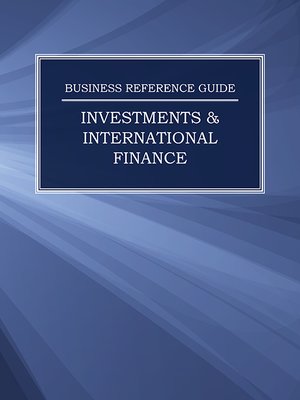
Sign up to save your library
With an OverDrive account, you can save your favorite libraries for at-a-glance information about availability. Find out more about OverDrive accounts.
Find this title in Libby, the library reading app by OverDrive.



Search for a digital library with this title
Title found at these libraries:
| Library Name | Distance |
|---|---|
| Loading... |
This volume begins with an essay by William Wardrope that details important concepts regarding investment valuation
and analysis. The primary investment vehicles that valuation can help with are stocks, bonds and money markets,
each of which have their own advantages and disadvantages. Wardrope provides information on different tools for
evaluating these pros and cons before Simone I. Flynn focuses on investment management and its history. Some of
the prominent management strategies include active investment and passive investment. Flynn also analyzes pension
funds, assets, government regulation and investment portfolios. Marie Gould expands on Flynn’s ideas by exploring
modern portfolio theory and post modern portfolio theory. According to Gould, modern portfolio theory asserts that
investors seek to mitigate risk by diversifying their portfolio while “post modern portfolio theory guides the path
toward an enriched science of investment that assimilates… behavioral finance with other forms of novelty that results
in more positive outcomes.” An investment vehicle opportunity investors often utilize in reducing risk is fixed income
securities. As Steven R. Hoagland notes, fixed income securities are risk-free bonds which the government will buy
and sell both on a daily basis and in cycles. Wardrope furthers the analysis of fixed income securities by noting some
of the advantages and disadvantages with such investments. He also points out that these securities can also include
corporate bonds, savings accounts, and certificates of deposit. For those investments that are considered much riskier
than fixed income securities, investors often apply financial hedging principles. These principles, as discussed by
Michael P. Auerbach, help investors determine how much risk might be worth the potential returns of an investment.
Investments that often find themselves accompanied by high amounts of risk are derivatives. Marlanda English and
Carolyn Sprague delve into great detail about the processes of investing in financial derivatives while at the same time
offering a wealth of information regarding sound strategies for risk management.







